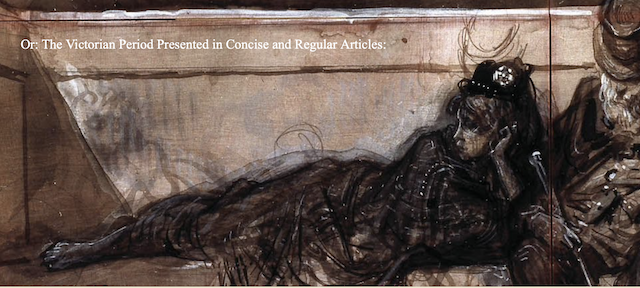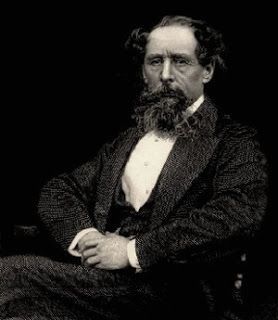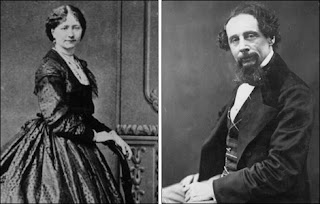 Any fan of Dickens will know that he died before he could finish ‘The Mystery of Edwin Drood’. But, if not for him surviving a train accident in Kent in 1865, his last piece of work could well have been ‘Our Mutual Friend’
Any fan of Dickens will know that he died before he could finish ‘The Mystery of Edwin Drood’. But, if not for him surviving a train accident in Kent in 1865, his last piece of work could well have been ‘Our Mutual Friend’
On the 9th June 1865, Dickens was traveling back from a holiday in France in a first class carriage at the front of the Folkestone Boat Express train. Ellen Ternan, the actress for whom he had left his wife Catherine Hogarth two years previously, and her mother were traveling with him. Also accompanying them was another important passenger; the manuscript of the latest installment of the novel he was writing at the time; ‘Our Mutual Friend’.
The train tracks in an area immediately prior to a low cast iron girder bridge near Staplehurst were in the process of being renovated and repaired. The timber baulks of the bridge – which crossed the little River Beult – were in the process of being replaced, but at the time of the crash these replacements had not yet been fitted.
 The Folkestone Boat Express train carried passengers who had arrived on the south coast of England on ferries and ships, and so its departure times were largely dependant on the tides, which often altered the times that boats arrived at port, and therefore the times at which the trains ran.
The Folkestone Boat Express train carried passengers who had arrived on the south coast of England on ferries and ships, and so its departure times were largely dependant on the tides, which often altered the times that boats arrived at port, and therefore the times at which the trains ran.
The foreman of the track works, John Benge, was carrying out the work in the time between trains, rather than close the track off. He had a copy of the timetable which showed the running times of normal trains and also the boat trains. He had been informed that there were two hours until the next train would be passing by the work site, and had posted a lookout, John Wiles, a little further down the track to give the workers and train driver warning, should a train unexpectedly appear chugging down the tracks toward the work site.
Unfortunately, John Benge had misread the timetable, thinking the train was due to pass by the works at 17:20. In fact, it was due at 15:15.
John Wiles, the lookout, should have been posted a thousand yards from the work site, from which distance he may have effectively been able to warn the driver about the lack of track ahead in time. John Benge had placed him only 554 yards from the work site, meaning he was not far away enough from the works to give adequate warning to the fast approaching train.
As an additional safeguard for such situations, the standard practice was to place detonators on the track at 250 yard intervals over a distance of around a thousand metres. The detonators would explode under the wheels of any unexpected train as it drove over them and the driver would thus be warned of danger ahead. These detonators should have been placed on the track by John Wiles, but he had been given only two detonators rather than the three required. He had also been told that the detonators need not be placed on the track unless visibility was poor, saying that the driver would see the lookout and stop. It was a bright sunny afternoon; detonators were not put in place.
Work carried on at the site, where two 21ft lengths of rail still needed to be laid on the bridge, and the train trundled down the track on its way to London, everyone involved was unaware of what lay ahead – including Charles Dickens.
The driver of the train saw John Wiles waving his red warning flag, but, being only just over 550 yards from the work site and the unsafe – largely unsupported – bridge, it was too late for the driver to stop the train, which was traveling at 30mph. (Quite fast in a time when the only other means of transport was a horse – pulled cab or carriage)
The engine and the first part of the train went across the 21 foot breach, avoiding plunging into the River Beult through a mixture of momentum and luck. Coaches in the middle and the rear of the train, however, fell through the breach and plunged into the river below. All of the first class coaches fell into the river, apart from one: The coach that carried Charles Dickens and his companions.
Although their carriage did not fall through the gap, it was hanging dangerously off the bridge as the picture below – from the Illustrated London News – shows. Dickens and Ellen Ternan’s mother were unharmed, whilst Ellen suffered minor injuries. They were extremely lucky.
Ten people were killed and about fifty were injured.
The Illustrated London News Picture – Dickens’ Carriage is to the Right of the Image, Hanging From the Bridge
Dickens helped Ellen and her mother from the coach before going about tending to fellow passengers and assisting people to escape from other carriages.
He bravely went back into the train where he managed to recover his top hat and a flask of brandy. He used his hat as a vessel, filling it with water for the injured to drink or wash their wounds and gave people mouthfuls of the brandy, including a badly injured lady he had found by a tree. The next time he passed this lady, she was dead.
The already shocked passengers who recognized him must have thought they had received a particularly bad knock to the head – looking up to see this famous author tending to them. A male passenger could be seen, but nobody could reach him. He was pinned beneath the train. He later died where he lay. For three hours Dickens went about the survivors doing what he could to help and assist until help arrived.
As the accident site and the remaining carriages were being cleared and evacuated by the emergency services, Dickens remembered about the other important passenger that had accompanied he and the Ternans’.
He made the dangerous journey back into the wrecked carriage in which he had been traveling, which still hung precariously from the bridge. He risked his life, but managed to rescue his other companion: the latest installment of ‘Our Mutual Friend’.
In the post-script of the above novel, Dickens referenced the accident, writing:
On Friday the Ninth of June in the present year, Mr and Mrs Boffin (in their manuscript dress of receiving Mr and Mrs Lammle at breakfast) were on the South Eastern Railway with me, in a terribly destructive accident. When I had done what I could to help others, I climbed back into my carriage – turned over a viaduct, and caught aslant upon the turn – to extricate the worthy couple. They were much soiled, but otherwise unhurt. The same happy result attended Miss Bella Wilfer on her wedding day, and Mr Riderhood inspecting Bradley Headstone’s red neckerchief as he lay asleep. I remember with devout thankfulness that I can never be much nearer parting company with my readers for ever, than I was then, until there shall be written against my life, the two words with which I have this day closed this book. – THE END
He became a public hero for his efforts in helping the dying and injured passengers, but the experience affected Dickens psychologically for the rest of his life. He wrote the short story ‘The Signal-Man’ a few years after the accident, in which a rail crash occurs in a tunnel. For the rest of his life Dickens would try to avoid travel by high speed rail, and even suffer from sudden feelings of anxiety when he was traveling by slower, stopping train services, which he made every effort to do in a bid to avoid faster, direct trains.

Ellen Ternan and Dickens
Dickens wrote an account of the incident in a letter to an old school friend Thomas Mitton, five days after it occurred. In it, the author describes his experiences in helping the injured, and his distress can be keenly felt in his words. Note also how he does not refer to Ellen or his mother in any familiar terms:
My dear Mitton,
I should have written to you yesterday or the day before, if I had been quite up to writing. I am a little shaken, not by the beating and dragging of the carriage in which I was, but by the hard work afterwards in getting out the dying and dead, which was most horrible.
I was in the only carriage that did not go over into the stream. It was caught upon the turn by some of the ruin of the bridge, and hung suspended and balanced in an apparently impossible manner. Two ladies were my fellow passengers; an old one, and a young one. This is exactly what passed:- you may judge from it the precise length of the suspense. Suddenly we were off the rail and beating the ground as the car of a half emptied balloon might. The old lady cried out “My God!” and the young one screamed.
I caught hold of them both (the old lady sat opposite, and the young one on my left) and said: “We can’t help ourselves, but we can be quiet and composed. Pray don’t cry out.” The old lady immediately answered, “Thank you. Rely upon me. Upon my soul, I will be quiet.” The young lady said in a frantic way, Let us join hands and die friends.”
We were then all tilted down together in a corner of the carriage, and stopped. I said to them thereupon: “You may be sure nothing worse can happen. Our danger must be over. Will you remain here without stirring, while I get out of the window?” They both answered quite collectedly, “Yes,” and I got out without the least notion of what had happened.
Fortunately, I got out with great caution and stood upon the step. Looking down, I saw the bridge gone and nothing below me but the line of the rail. Some people in the two other compartments were madly trying to plunge out of the window, and had no idea there was an open swampy field 15 feet down below them and nothing else! The two guards (one with his face cut) were running up and down on the down side of the bridge (which was not torn up) quite wildly. I called out to them “Look at me. Do stop an instant and look at me, and tell me whether you don’t know me.” One of them answered, “We know you very well, Mr Dickens.” “Then,” I said, “my good fellow for God’s sake give me your key, and send one of those labourers here, and I’ll empty this carriage.”
We did it quite safely, by means of a plank or two and when it was done I saw all the rest of the train except the two baggage cars down in the stream. I got into the carriage again for my brandy flask, took off my travelling hat for a basin, climbed down the brickwork, and filled my hat with water. Suddenly I came upon a staggering man covered with blood (I think he must have been flung clean out of his carriage) with such a frightful cut across the skull that I couldn’t bear to look at him. I poured some water over his face, and gave him some to drink, and gave him some brandy, and laid him down on the grass, and he said, “I am gone”, and died afterwards.
Then I stumbled over a lady lying on her back against a little pollard tree, with the blood streaming over her face (which was lead colour) in a number of distinct little streams from the head. I asked her if she could swallow a little brandy, and she just nodded, and I gave her some and left her for somebody else. The next time I passed her, she was dead.
Then a man examined at the Inquest yesterday (who evidently had not the least remembrance of what really passed) came running up to me and implored me to help him find his wife, who was afterwards found dead. No imagination can conceive the ruin of the carriages, or the extraordinary weights under which the people were lying, or the complications into which they were twisted up among iron and wood, and mud and water.
I don’t want to be examined at the Inquests and I don’t want to write about it. It could do no good either way, and I could only seem to speak about myself, which, of course, I would rather not do. I am keeping very quiet here. I have a – I don’t know what to call it – constitutional (I suppose) presence of mind, and was not in the least flustered at the time. I instantly remembered that I had the MS of a Novel with me, and clambered back into the carriage for it. But in writing these scanty words of recollection, I feel the shake and am obliged to stop.
Ever faithfully,
Charles Dickens
It’s clear – particularly from the last few lines – the effect the crash had on the 53 year-old Dickens. For his entire career his writing had been prolific, but after the crash he finished ‘Our Mutual Friend’ and for the next four and a half years wrote very little, but performed public readings of his work. His next novel was ‘The Mystery of Edwin Drood’ which started serialization in April 1870.
On 9th June 1870 – on the five year anniversary of the Staplehurst crash – Charles Dickens suffered from the last of a series of strokes at his home at Gad’s Hill Place. This stroke was fatal and he never awoke, dying at the age of 58 leaving ‘The Mystery of Edwin Drood’ only half finished.
His last words according to his obituary in The Times were: “Be natural my children. For the writer that is natural has fullfilled all the rules of art.”
Of course, nobody knows whether Dickens would have lived any longer had the Staplehurst crash not occurred, but it is something that will always be wondered. One of the real tragedies of Dickens dying when he did is that, had he lived only another seven years or so, we may have had a sound recording of him speaking, or even reading one of his novels at a public reading.
Written by The Amateur Casual for The Victorianist ~ January 14, 2011
